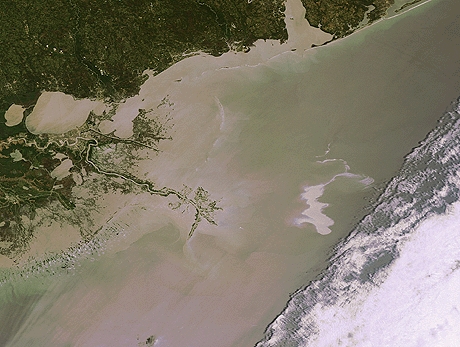The Transocean Deepwater Horizon drilling rig exploded on April 20, 130 miles south-east of New Orleans, injuring 17 workers, with 11 unaccounted for. The burning rig then sank on the morning of April 22 causing a 600-mile wide area of crude oil to appear 36 miles off the coast of Louisiana.
Accounts suggest that a sudden increase in pressure led to the accident, which caused oil to spew out from the surface of the seabed. In events such as these, a device called a blowout preventer (BOP) is automatically activated to cut the flow.
However, an unknown cause meant that the BOP on Deepwater Horizon failed. ‘A BOP failure is uncommon,’ said Greville Williams, an energy specialist at IHS, ‘I can only speculate what might be the cause of the blowout preventer failing to close, but loss of hydraulic fluids or incorrect sizing are two possibilities.’
BOPs are large valves fitted to the surface of a well used to shut off oil flow in the event of high-pressure fluid areas forming beneath the surface. Transocean said that the failure is still being investigated and that the incident appeared to be ’completely unique’.
BP, which leased the Deepwater Horizon platform from Transocean, has now sent remote-control submersibles to close the BOP manually.
If this fails, BP will drill relief wells to permanently secure the main well. The drilling rig will inject a specialised heavy fluid to securely prevent flow of oil or gas and allow work to be carried out to permanently seal the well.
So far, the oil-spill response team has recovered 43,384 gallons of an oil-water mix. 49 response vessels are being used, including skimmers, tugs, barges and recovery vessels.
Engineers are also looking to deploy a giant dome, which is currently still in the design stages, to contain the oil spill and pump contaminated water into tanks on the surface. Similar dome concepts were used in the wake of Hurricane Katrina to contain leaks from coastal oil developments.
‘We are attacking this spill on two fronts – at the wellhead and on the surface offshore,’ said Tony Hayward, BP Group chief executive. ‘The team on the ground and those at sea have the group’s full resources behind them.’
Officials said that they were investigating the possibility of burning oil captured from the inflatable containment booms floating in the gulf. The US Coast Guard has warned that the oil slick could develop into one of the worst in US history.

Incident Facts:
A flyover on Wednesday, April 28 at 2:00 p.m. (CDT), continued to show a large, rainbow sheen with areas of emulsified crude, approximately 16 miles off the coast of Louisiana.
On April 28 at approximately 4:45 p.m. (CDT), the response team conducted a successful, controlled in-situ burn and is evaluating conducting additional burns.
More than 174,060 feet of boom (barrier) has been assigned to contain the spill. An additional 243,260 feet is available and 265,460 feet has been ordered.
To date, the oil spill response team has recovered 18,180 barrels (763,560 gallons) of an oil-water mix. Vessels are in place and continuing recovery operations.
76 response vessels are being used including skimmers, tugs, barges and recovery vessels.
98,361 gallons of dispersant have been deployed and an additional 75,000 gallons are available.
Five staging areas are in place and ready to protect sensitive shorelines. These areas include:
Biloxi, Miss., Pensacola, Fla. Venice, La., Pascagoula, Miss., and Theodore, Ala.
Weather conditions for April 29 - Winds from the southeast at 5-15 mph, choppy rough seas.
126 people were on the Deepwater Horizon drilling rig when the incident occurred. 11 remain unaccounted for; 17 were injured, 3 of them critically. 1 injured person remains in the hospital.
Source:
Unified Command for the Transocean Deepwater Horizon drilling rig accident
http://www.deepwaterhorizonresponse.com/











Water Sector Talent Exodus Could Cripple The Sector
Maybe if things are essential for the running of a country and we want to pay a fair price we should be running these utilities on a not for profit...